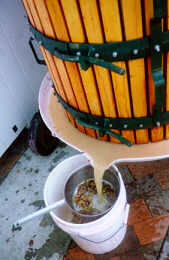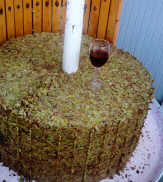| Introduction
| How Wine is made I
| How Wine is made II
| How Wine is made III |
| Climate and Quality
| Serving and Testing
| Wine and Food
|
II. HOW WINE IS MADE II
Initial Processing of the Grape Juice
Grapes can (and might still) be crushed by stomping
on them with your feet in a big vat. But a more practical way is to use
a machine which does the job (and at the same time, removes the stems).

What you get may or may not get
 immediately separated. Skin and seeds might immediately be removed from the juice.
Separation may not immediately occur (especially for red wines), since
skins and stems are an important source of "tannins"
which affect wine's taste and maturity through aging. The skins also determine
the color of the wine (see What
is Wine).
immediately separated. Skin and seeds might immediately be removed from the juice.
Separation may not immediately occur (especially for red wines), since
skins and stems are an important source of "tannins"
which affect wine's taste and maturity through aging. The skins also determine
the color of the wine (see What
is Wine).
Maceration (the time
spent while skins and seeds are left with the juice) will go on for a few
hours or a few weeks. Pressing will then occur.
One way to press the grapes is to use a "bladder press,"
a large cylindrical container that contains bags that are inflated and
deflated several times,
 each
time gently squeezing the grapes until all the juice has run free, leaving
behind the rest of the grapes. You can also separate solids from juice
through the use of a centrifuge.
each
time gently squeezing the grapes until all the juice has run free, leaving
behind the rest of the grapes. You can also separate solids from juice
through the use of a centrifuge.
Aside: When I first started drinking Chardonnay,
my tastes ran to wines with heavy flavors of oak (introduced in the barrel
aging process by storing in wood barrels). Then I was lucky enough to be at the Sonnen winery in
Middle Rheinvalley during harvest.
process by storing in wood barrels). Then I was lucky enough to be at the Sonnen winery in
Middle Rheinvalley during harvest.
The friendly people there had me
take a wine glass and hold it under the device that was extracting juice
from the grapes. Fending off the bees, which were very attracted to the
sweet fluid, I got a taste of absolutely fresh unfermented
Chardonnay grape juice.
It was wonderful. I then knew what Chardonnay actually
tasted like! From that point on my tastes have run to a different balance
of oak and fruit flavors in the wine. The best way to learn about wine
is to drink it. Sometimes it even helps if it isn't even wine yet . . .
must weight
 The must weight is expressed as Oechsle degrees and can be measured on a thermometer-
The must weight is expressed as Oechsle degrees and can be measured on a thermometer-
From this rating, the potential alcohol level of the finished wine can be determined,
the basis for quality category classification.
Different grape varieties ripen at different times - the
Müller-Thurgau "a very popular german wine) around the end of September; the Riesling in mid- to late October or November,
depending on the weather and the vineyard site (micro-climate, soil structure).

It is the vintner who determines how long to risk leaving his grapes on the vine. A sudden frost or long period of rain could destroy the crop. Starting in late summer, the winegrower as well as the local authorities begin to measure how much sugar has developed in the grapes' juice, or must, which is a indication of ripeness. The sugar content can be measured in the vineyard by the vintner using a refractometer.
Vintages
Every vintage cannot produce large quantities of the higher
but good and pleasant wines are produced every year in Germany.

Wine is an agricultural product and consequently very dependent on the weather which in Germany, unlike more southerly climates, can be extremely variable. Although different vintages may exhibit subtle differences in taste and style, the German classification system, based on ripeness, assures the consumer of the quality of each bottle, regardless of the vintage.
Grape juice is turned into alcohol by the process
of "fermentation." Grapes on the vine
are covered with yeast, mold and
bacteria. By putting grape juice into a container
at the right temperature, yeast will turn the sugar in the juice into alcohol
and carbon dioxide. The grape juice will have fermented.

Yeast gives flavor to wine. However things on
the outside of a grape are not necessarily so good for the production of
good wine (for example, acetic bacteria on
the grapes can cause the wine to turn to vinegar).
The winemaker commonly eliminates unwanted contaminants by using the "universal
disinfectant," sulfur dioxide.
Unfortunately, the sulfiteswhich remain in the wine
may cause a lot of discomfort to some wine drinkers (see the section on
Allergic Reactions to Wine).
Some winemakers prefer not to
do this, and purposely create wines that are subject to the vagaries (and
different flavors) of yeast that is "wild," that is not a commercial
yeast strain used by the winemaker ("wild yeast fermentation").
By the way, some have said that these wild yeasts are found on the grape,
but a number of people have commented that there is no documentation that
any wild yeast living on the skins of grapes leads to alcoholic fermentation.
They propose that these "spontaneous" fermentations occur due
to commercial yeast populations that live in the winery and have become
"wild" over several generations--and have not been cleaned away
or otherwise eradicated.
The winemaker has many different yeast strains to choose from (and can use different strains at different times during the process). The most common wine yeast is Saccharomyces. This is a good place to mention "Brett" or the Brettanomyces strain of yeast. But since it is a side-light and this is written as a hyper-text document, you can check it out now. Otherwise, you will find the discussion as the next section. As yeast works, it causes grape juice ("must") to get hot. But if there's too much heat, the yeast won't work. One modern way to deal with this is to put the juice into large stainless steelcontainers that have refrigeration systems built around the sides. The winemaker canregulate temperature precisely.
residual sugar

When fermentation is completed, the wine is usually completely dry (trocken), because the yeast has converted all of the sugar into CO2 and alcohol. By volume the yeast is "exhausted" and no longer able to convert sugar into CO2 and alcohol. But yeast has its limits: if the must had a very high sugar content (very ripe or overripe grapes), once the amount of alcohol produced reaches 12-15%. Some of the original, natural sugar will remain in the wine - this is called residual sugar.